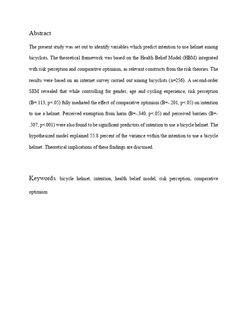| dc.contributor.author | Zavareh, Mohsen Fallah | |
| dc.contributor.author | Hezaveh, Amin Mohamadi | |
| dc.contributor.author | Nordfjærn, Trond | |
| dc.date.accessioned | 2019-05-06T07:33:54Z | |
| dc.date.available | 2019-05-06T07:33:54Z | |
| dc.date.created | 2018-02-03T17:30:29Z | |
| dc.date.issued | 2018 | |
| dc.identifier.citation | Transportation Research Part F: Traffic Psychology and Behaviour. 2018, 54 248-263. | nb_NO |
| dc.identifier.issn | 1369-8478 | |
| dc.identifier.uri | http://hdl.handle.net/11250/2596529 | |
| dc.description.abstract | The present study was set out to identify variables which predict intention to use helmet among bicyclists. The theoretical framework was based on the Health Belief Model (HBM) integrated with risk perception and comparative optimism, as relevant constructs from the risk theories. The results were based on an internet survey carried out among bicyclists (n = 256). A second-order SEM revealed that while controlling for gender, age and cycling experience, risk perception (β = .113, p < .05) fully mediated the effect of comparative optimism (β = −.201, p < .05) on intention to use a helmet. Perceived exemption from harm (β = −.340, p < .05) and perceived barriers (β = −.507, p < .001) were also found to be significant predictors of intention to use a bicycle helmet. The hypothesized model explained 55.8 percent of the variance within the intention to use a bicycle helmet. Theoretical implications of these findings are discussed. | nb_NO |
| dc.language.iso | eng | nb_NO |
| dc.publisher | Elsevier | nb_NO |
| dc.rights | Attribution-NonCommercial-NoDerivatives 4.0 Internasjonal | * |
| dc.rights.uri | http://creativecommons.org/licenses/by-nc-nd/4.0/deed.no | * |
| dc.title | Intention to use bicycle helmet as explained by the Health Belief Model, comparative optimism and risk perception in an Iranian sample | nb_NO |
| dc.type | Journal article | nb_NO |
| dc.type | Peer reviewed | nb_NO |
| dc.description.version | acceptedVersion | nb_NO |
| dc.source.pagenumber | 248-263 | nb_NO |
| dc.source.volume | 54 | nb_NO |
| dc.source.journal | Transportation Research Part F: Traffic Psychology and Behaviour | nb_NO |
| dc.identifier.doi | 10.1016/j.trf.2018.02.003 | |
| dc.identifier.cristin | 1561500 | |
| dc.description.localcode | © 2018. This is the authors’ accepted and refereed manuscript to the article. Locked until 24.2.2020 due to copyright restrictions. This manuscript version is made available under the CC-BY-NC-ND 4.0 license http://creativecommons.org/licenses/by-nc-nd/4.0/ | nb_NO |
| cristin.unitcode | 194,67,40,0 | |
| cristin.unitname | Institutt for psykologi | |
| cristin.ispublished | true | |
| cristin.fulltext | original | |
| cristin.fulltext | postprint | |
| cristin.qualitycode | 1 | |

